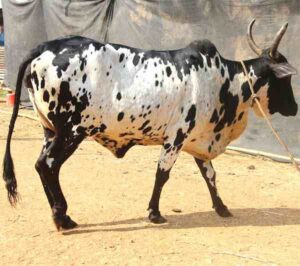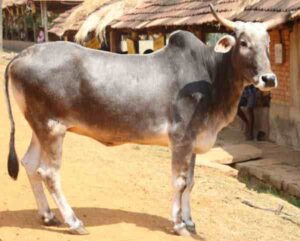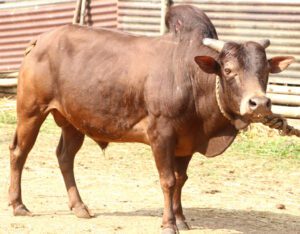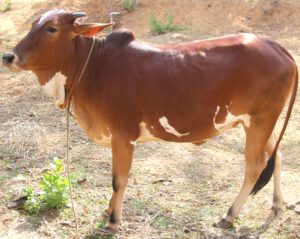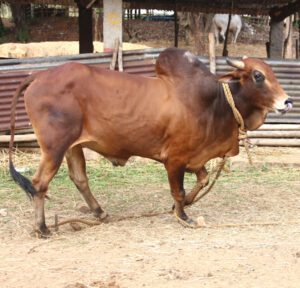The Khillari cattle are a draught breed of cattle native to Satara, Kolhapur and Sangli regions in Maharashtra and Bijapur, Dharwad and Belgaum districts of Karnataka in India.
It is of Bos indicus sub-species and is well adapted to the tropical and drought prone conditions of these area. Most recently the breed is showing a steady decline in numbers mainly because of the low milk production which forms an alternate stream of income for the local farming community.
The Khillari cattle breed has many varieties. And the breed with it’s several varieties, possibly owes it’s origin to the Hillikar cattle breed from Mysore state or from the Maharashtra state.
Name of the breed ‘Khillari’ came from ‘Khillar’ which means a herd of cattle. And meaning of the word ‘Khillari’ is the herdsman. Mostly these animals are basically from Satara district of south Maharashtra.
And the animals are also found in the neighboring districts of Sangli, Kolhapur and Solapur of western Maharashtra. However, read more information about the breed below.
Khillari Cattle Characteristics
Khillari cattle are small sized animals. They are usually compact and tight skinned with clean cut features and squarely developed hindquarters. Their overall appearance is compact with stout strong limbs.
The pelvis of these animals is slightly higher than the shoulders. There are four main types of the Khillari cattle in the different regions of Maharashtra state.
These varieties are Hanam Khillar (sometimes known as Atpadi Mahal), Mhaswad Khillari, Tapi Khillari or Thillari and the Nakali Khillari. The Hanam Khillar or Atpadi Mahal variety is available in the southern Maharasthra and the Mhaswad Khillari variety is available in the districts of Kolhapur and Satara and the adjoining areas.
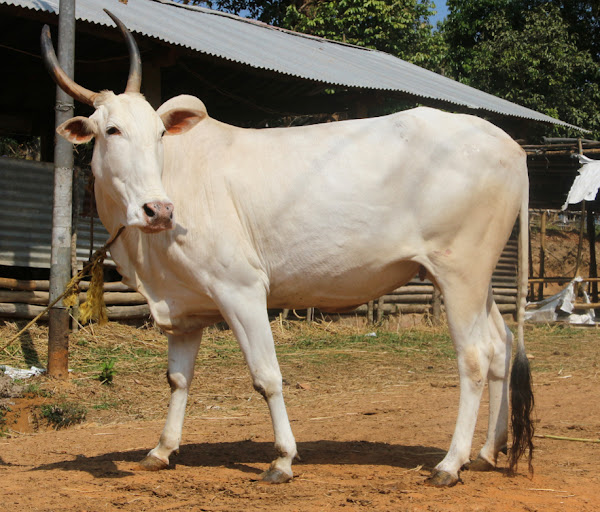
The Tapi Khillari or Thillari variety prevalent in the area of the Satpura range of hills comprising the West Khandesh district. And the most recent Nakali Khillari variety is found in the adjacent areas of these regions.
All these varieties are pretty different in coloration. The Khillaris of the Deccan plateau, the Mhaswad and the Atpadi Mahal types are greyish white in color, the males having deeper color over the forequarters and hindquarters, with peculiar grey and white mottling on the face.
Color of the Tapti Khillari cattle is white with reddish nose and hooves. And the Nakali Khillari is grey with tawny or brickdust color over the forequarters.
Newly born calves of these animals have rust red colored polls and this disappears within a couple of months. Most varieties of the Khillari cattle have a long narrow head with long horns.
Their horns are sweeping back and then upward in a distinctive bow, and tapering to a fine point. Their coat is fine, short and glossy and the ears are small and pale yellow colored inside.
Legs of the animals are round and straight with black hooves. Muzzle of the Khillari cattle is frequently mottled in color.
Both bulls and cows usually have hump. And the hump in the bulls is firm fleshed and of moderate size. Their shoulders are tightly muscled, well set in and merge smoothly with the cylindrical shape of the body.
As a small sized animal, average body weight of the bulls is about 450 kg. And the cows on average weight about 360 kg. Photo and info from Wikipedia.
Uses
The Khillari cattle are mainly used as a draught animal. The cows are not good milkers and not suitable for profitable milk production.
Special Notes
The Khillari cattle are very hardy and active animals. They are well adapted to the tropical and draught prone conditions present in the Maharashtra and Karnataka state.
They are favored by the local farming community mainly because of their ability to handle hardships of farming. They are bred by the cultivators in the southern Maharashtra and the districts of Sholapur, Sangli and Satara.
Small herds are kept in these region and the size of the herd is usually not more than one or two cows.
The Khillari cattle are bred by professional breeders in the Satpura ranges. These breeders produce bulls and bullocks for which there is always a very good demand.
The animals are also used in the adjacent districts of Ahmednager, Bijapur, Nasik and Pune besides their extensive use in their home tracts.
Most recently total number of these animals has decreased, mostly due to their low milk production. The cows are not among the good milk producing cattle breeds. Review full breed profile of the Khillari cattle in the following chart.
| Breed Name | Khillari | |
| Other Name | Hanam Khillar (sometimes known as Atpadi Mahal), Mhaswad Khillari, Tapi Khillari or Thillari and the Nakali Khillari | |
| Breed Purpose | Draught | |
| Special Notes | Well adapted to the tropical and draught prone areas | |
| Breed Size | Small | |
| Bulls | 450 kg | |
| Cows | 360 kg | |
| Climate Tolerance | Native climates | |
| Coat Color | Many, but mainly greyish white | |
| Horned | Yes | |
| Milk Yield | Poor | |
| Rarity | Common | |
| Country/Place of Origin | India |

